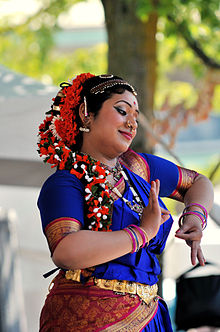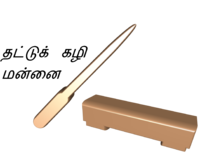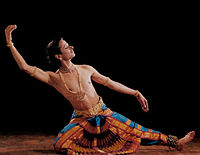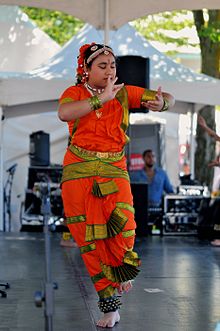- Bharata Natyam
-
 Indian dancer portraying a characteristic Nataraja pose
Indian dancer portraying a characteristic Nataraja pose
Bharata Natyam or Chadhir Attam(Tamil: பரதநாட்டியம்), is a classical dance form from the South Indian state of Tamil Nadu, practiced predominantly in modern times by women. The dance is usually accompanied by classical Carnatic music. Its inspirations come from the sculptures of the ancient temple of Chidambaram.
Contents
Traditional roots
Texts surviving from the golden age of Tamil literature and poetry, known as the Sangam Age, such as the Tolkappiyam (தொல்கப்பியம்), as well as the later Silappadikaram (சிலப்பதிகரம்), testify to a variety of dance traditions of Koothu which flourished in these times. The latter work is of particular importance, since one of its main characters, the courtesan Madhavi, is a highly accomplished dancer. The Silappadikaram is a mine of information of ancient Tamil culture and society, during which the arts of music and dance were highly developed and played a major role.[1]
In ancient times Bharata Natyam was performed as "sadir attam" (sadir refers to the square stage, 'chatura' in Sanskrit) by Kovil (temple) Devadasis. Many of the ancient sculptures in Hindu temples are based on Bharata Natyam karanas or dance postures. In fact, it is the celestial dancers (apsaras) who are depicted in many scriptures as dancing the heavenly version of what is known on earth as Bharata Natyam. In the most essential sense, a Hindu deity is a revered royal guest in his temple/abode, to be offered the "sixteen hospitalities" — among which are music and dance to please the senses. Thus, many Hindu temples traditionally maintained complements of trained musicians and dancers, as did Indian rulers.
In Kali Yuga, the center of most arts in India is Bhakti (devotion) and therefore, Bharata Natyam as a dance form and the Carnatic music set to it are deeply grounded in Bhakti. Bharata Natyam, it is said, is the embodiment of music in visual form, a ceremony, and an act of devotion. Dance and music are inseparable forms; only with Sangeetam (words or syllables set to raga or melody) can dance be conceptualized. Bharata Natyam has three distinct elements to it: Nritta (rhythmic dance movements), Natya (mime, or dance with a dramatic aspect), and Nritya (combination of Nritta and Natya).
The Tamil country especially Tanjore, has always been the seat and centre of learning and culture. It was the famous Tanjore quartet of Chinnayya, Ponniah, Sivanandam and Vadivelu of the Tanjore Court during the Marathi King Saraboji’s time (1798–1824) which made a rich contribution to music and Bharata Natyam and also completed the process of re-editing the Bharathanatyam programme into its present shape with its various forms like the Alaripu, Jathi-Svaram, Varanam, Sadanam, Padam and Tillana. The descendants of these four brothers formed the original stock of Nattuvanars or dance teachers of Bharata Natyam in Tanjore. Originally, they formed a community by themselves and most of them were Saivite non-Brahmins.
It is believed that Bharata Natyam is mainly a renewal of Cathir, the ancient art of temple dancers. This dance form denotes 19th and 20th century reconstructions of Cathir.
Fire dance
Bharata Natyam is considered to be a 'fire dance' — the mystic manifestation of the metaphysical element of fire in the human body. It is one of the five major styles (one for each element) that includes Odissi (water), Mohiniattam (air), Kuchipudi (earth) and Kathakali (sky). The movements of an authentic Bharata Natyam dancer resemble the movements of a dancing flame. Contemporary Bharata Natyam is rarely practiced as Natya Yoga, a sacred meditational tradition, except by a few orthodox schools.
Bharata Natyam proper is a solo dance, with two aspects — lasya, the graceful feminine lines and movements, and tandava Ananda Thandavam (Tamil) (the dance of Shiva), masculine aspect — which is identical to the Yin and Yang in the Chinese culture.
Spiritual symbolism
Bharata Natyam is the manifestation of the ancient idea of the celebration of the eternal universe through the celebration of the beauty of the material body. Some Bharata Natyam techniques can be traced back to the Kaisiki style. The Natya reads,
"I have seen the Kaisiki style during the dance of the blue-throated lord (Shiva). It consists of elaborate gestures ("Mridu Angaharas", movements of limbs), sentiments (Rasas), emotional states (Bhavas). Actions (Kriyas) are its soul. The costume should be charmingly beautiful and love (Sringara) is its foundation. It cannot be adequately portrayed by men. Except for women, none can practise it properly."
Apart from the Kaisiki style, Bharata Natyam imbibed some others. These reflect other yogis spiritual revelations, such as the vision of two sages, Vyagrapada and Pathanjali in Chidambaram. In Hindu mythology the whole universe is the dance of the Supreme Dancer, Nataraja, a name for Lord Shiva, the Hindu ascetic yogi and divine purveyor of destruction of evil. The symbolism of the dance of Shiva (in the form of Nataraja) is represented by the attitude called "Ananda Tandavam". Also known as the cosmic dancer, he is here the embodiment and manifestation of the eternal energy in five activities (panca-kriya): creation, pouring forth, unfolding; maintenance or duration (sthiti); destruction or taking back (smhara); concealing, veiling, hiding the transcendental essence behind the garb of apparations (tirobhava); and favoring, bestowing grace through a manifestation that accepts the devotee (anugraha). Shiva is depicted dancing on the dwarfish body of the demon Apasmara purusa, "forgetfulness, loss of memory" called in Tamil Muyalaka (முயலக), who represents ignorance, the destruction of which brings enlightenment, true wisdom, and release from the bondage of existences.[2]
Medieval decline
 Bharata Natyam in Serfoji II's period
Bharata Natyam in Serfoji II's period
Local kings often invited temple dancers (devadasi) to dance in their courts, the occurrence of which created a new category of dancers ("rajanarthakis") and modified the technique and themes of the recitals. A devadasi had to satisfy her own soul while she danced unwatched and offered herself (surrendered) to the Lord, but the rajanarthaki's dance was meant to be an entertainment.
The Natya Shastra-based margi elements, such as karanas, that were meant to spiritually enlighten the spectators, were gradually replaced by desi karanas which were later replaced by adavus. The Bharata Natyam recitals and ballets started more and more popularly viewed as a form of desi entertainment.
The Tanjore Quartet of Chinnayya, Ponniah, Sivanandam and Vadivelu of the Tanjore Court, during the rule of Maratha King Saraboji II (1798–1832), made a rich contribution to music and Bharata Natyam and also completed the process of re-editing the Bharathanatyam programme into its present shape with its various items. The descendants of these four brothers formed the original stock of Nattuvanars or dance teachers of Bharata Natyam in Tanjore. Originally, they formed a community by themselves and most of them were Shaivite non-Brahmins. The fall of the Hindu kingdoms in the South marked the eventual decline of Natya, as the Muslim invasion in the North has completely wiped out Natya there. The sacred dance, one of the constituents of the Sodasa Upacharam, was replaced by rice offerings.
Modern rebirth
E. Krishna Iyer was one of those who raised the social status of Bharata Natyam and greatly popularized it.[3] Rukmini Devi Arundale was instrumental in bringing it to the attention of the West. Having studied the Pandanallur style for three years, in 1936 Rukmini Devi Arundale founded the Kalakshetra school outside the city of Madras to teach her own Kalakshetra style of Bharata Natyam and to promote other studies in Indian music and art. She was one of first teachers to instruct men to perform the dance. She introduced group performances and staged Bharata Natyam-based ballets.
According to Shri Sankara Menon, Rukmini Devi raised Bharata Natyam to a puritan art form, divorced from its recently controversial past by "removing objectionable elements" (mostly, the Sringara, certain emotional elements evocative of the erotic, such as hip, neck, lip and chest movements) from the Pandanallur style, which was publicly criticized by Balasaraswati and other representatives of the traditional devadasi culture. Not all love was portrayed, at least outside parameters considered "chaste". Balasaraswati said that "the effort to purify Bharata Natyam through the introduction of novel ideas is like putting a gloss on burnished gold or painting the lotus". E. Krishna Iyer said about Rukmini Devi, “There is no need to say that before she entered the field, the art was dead and gone or that it saw a renaissance only when she started to dance or that she created anything new that was not there before”. While the Pandanallur style, Tanjore or Thanjavur, Vazhuvoor, Mysore, Kancheepuram were based on the art of rajadasis and are exoteric in nature, some others, like the Melattur style and Balasaraswati's style grew out of the devadasis' distinctly different esoteric art.
The development of the Bharatnatyam dance form has therefore been surrounded by controversy as some including Ashish Khokar the Indian dance historian have seen it as a means by which many women, often Brahmin women, have appropriated certain Devadasi traditions while disassociating themselves with other aspects of the contemporary devadasis' practices.[4] The dance, at that time, was exclusively performed by women, while men, called nattuvanars, had been teaching Bharata Natyam without performing it. It is worth noticing that most of the contemporary Bharata Natyam dancers do not satisfy the criteria for a professional danseuse stated in the scriptures.
At present, Bharata Natyam recitals are usually not performed inside the temple shrine but outside it, and even outside the temple compounds at festivals. Most contemporary performances are given on the stage with a live ensemble. In popular culture, the adapted, or "semi-classical", Bharata Natyam has been exposed largely through depiction in popular movies and television programs.
Learning Bharata Natyam normally takes many years before the arangetram (debut). There are academic and commercialized dance institutes in many countries. Many people choose to learn Carnatic music along with Bharata Natyam as they go together.
Technique
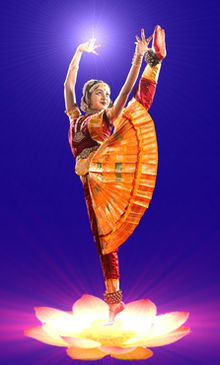 This Bharata Natyam dancer's right hand is in the Katakamukha Hasta, the three joined fingers symbolizing the sacred syllable Aum. The left hand's fingers are in Alapadma Hasta, the rotating lotus of spiritual light. The eyes are directed towards the Supreme Lord. The left leg is lifted, symbolizing the swift ascent of the consciousness in one step from the Earth to the Heaven.
This Bharata Natyam dancer's right hand is in the Katakamukha Hasta, the three joined fingers symbolizing the sacred syllable Aum. The left hand's fingers are in Alapadma Hasta, the rotating lotus of spiritual light. The eyes are directed towards the Supreme Lord. The left leg is lifted, symbolizing the swift ascent of the consciousness in one step from the Earth to the Heaven.
Includes
- Abhinaya or Natya - dramatic art of story-telling in Bharata Natyam
- Nritta - pure dance movements, as a medium of visual depiction of rhythms
- Nritya combination of abhinaya and nritta
In the margi form nritta is composed of karanas, while the desi nritta consists mainly of adavus.
Karanas
Karanas are the 108 key transitional movements that punctuate Bharata Natyam and other classical Indian dances. Most of these 108 Karanas have a central, static pose as a base, i.e., the dancer is usually supposed to stop and maintain it for a very brief duration.
Hastas
See also: List of mudrasA distinctive feature of Bharata Natyam is the use of expressive hand gestures as a way of communication. Hastas refers to the hand symbols that a dancer can use. Many of these hand gestures are well known. For example, Anjali is often used as a salutation when a person greets another person. The Tamil text Koothanool contains descriptions of over 300 hastas and mudras.
There are two types of Hastas: Asamyukta and Samyukta (single and combined, respectively). Abhinayadarpanam describes 28 Asamyukta Hastas (Pataka, Tripataka, Ardhapataka, Karktarimukha, Mayuryakyo, Ardhachandrashya, Arala, Shukatundako, Mhushtishya, Shikharakhachya,Khapitya, Khatakamukhyo, Suchi, Chandrakala, Padmakosha, Sarpashiras, etc.) and 24 Samyukta Hastas and their usage viniyoga, although Natya Shastra mentions many more. The usages stated in Abhinavabharati differ considerably from those of Abhinayadarpanam, which is a relatively recent text.
The gestures used in nritta are called nritta hastas, and are described in detail as part of karanas in Natya Shastra. Few Bharata Natyam schools use the full range of these. Many hastas can be used in more than one way, depending on the song accompanying the dance, and what the dancer is trying to convey to the audience.
Adavus
See also: List of AdavusThe basic unit in Bharata Natyam dance composition is the 'Adavu' (derived from 'adu' 'adi' - foot, base, Kannada for 'beat of the foot').[5] Adavus are a relatively recent desi component in Bharata Natyam. The dance steps were first categorized into adavus by Tanjore Quartet. The execution of adavus varies greatly from style to style. Most schools recognize 108 principal adavus, while some styles include over 150. Few professional dancers use more than 60. A combination of adavus is called jathis, which make up the Nritta passages in a Bharata Natyam performance. Unlike the margi Nritta composed of the Karanas, the adavus do not convey any rasa.
The main adavus are:
- Tatta Adavu
- Natta Adavu
- Visharu Adavu
- Tatti Metti Adavu
- Teermanam Adavu
- Sarikal Adavu
- Kuditta Metta Adavu
- Sutral (Murka) Adavu
- Jaati Adavu
- Mandi Adavu
Bhedas and eye movements
Bharata Natyam technique includes many other elements, such as elaborate neck and eye movements.
While Natya Shastra contains the largest number of the movements, and the most detailed descriptions, Abhinaya Darpanam, for instance, has defined only nine head movements, four neck movement and eight eye movements (compared with 36 of Natya Shastra) which are used extensively throughout the dance.
- Head movements (Shiro bhedas): Sama, Udhvahita, Adhomukha, Alolita,Dhutam, Kampitam, Paravruttam, Utkshiptam and Parivahitam.
- Neck movements (Griva bhedas): Sundari, Tirashchina, Parivartita, Prakampita
- Eye movements (Drishti bhedas): Sama, Alolita, Sachi, Pralokita, Nimilite, Ullokita, Anuvritta, Avalokita (who looks down)
Items
A Bharata Natyam performance lasts about two hours[6] and includes six or more of the following parts:
- Allarippu - A presentation of the Tala punctuated by simple syllables spoken by the dancer. This really is sort of an invocation to the gods to bless the performance.
- Kautuvam - Ancient temple dance item performed in the beginning of the recital, containing rhythmic syllables sung for jathis.
- Ganapati Vandana - A traditional opening prayer to the Hindu god Ganesh, who removes obstacles. See also Pushpanjali
- Jatiswaram - An abstract dance where the drums set the beat. Here the dancer displays her versatility in elaborate footwork and graceful movements of the body.
- Shabdam - The dancing is accompanied by a poem or song with a devotional or amorous theme.
- Varnam - The center piece of the performance. It is the longest section of the dance punctuated with the most complex and difficult movements. Positions of the hands and body tell a story, usually of love and the longing for the lover.
- Padam - Probably the most lyrical section where the dancer "speaks" of some aspect of love: devotion to the Supreme Being; or of love of mother for child; or the love of lovers separated and reunited.
- Stuti - Hymn in praise of a deity that may contain a feigned mockery, etc. See also Stotra
- Koothu - Item containing a lot of dramatic elements.
- Javali - Javalis are relatively new, pure abhinaya types of compositions of light and pleasing nature. Like Padams the underlying theme of Javalis is Sringara Rasa depicting the Nayaka-Nayaki bhava.
- Thillana - The final section is a pure dance (nritta) when the virtuosity of the music is reflected in the complex footwork and captivating poses of the dancer.
Apart from these items, there are items such as Shlokam, Swarajathi, Krithi etc. The performance concludes with the chanting of a few religious verses as a form of benediction. Certain styles include more advanced items, such as Tharanga Nritham and Suddha Nritham. When a dancer has mastered all the elements of dance, as a coming out performance, he or she generally performs an Arangetram (debut).
- Angikam - This is a devotional song on Lord Shiva and an item dance in bharatnatyam. It can be performed in byapti slow motion.
Currently, the sequence of items in most solo performances follow either of the two different margam sets: the Tanjore Quartet margam and the devadasi margam. Before the Tanjore Quartet, the format of a traditional Bharata Natyam performance followed this order:
- Jaya stuti
- Sharanu Sharanu
- Alaru (Alarippu)
- Sollu
- Shabdam
- Varnam
- Padam
- Swarajati
- Abhinaya Padam
- Thillana
- Abhinaya Padam
- Jakkini Padam
- Geetham
- Prabandham
- Triputa
- Shloka Varnam
- Kavuthuvam
- Mangale (Mangalam)
Bharatanatyam owns a unique place of pride in the world. Our motherland, India, can be proud of this wonderful and life-science rather. There are a lot of things that Bharatanatyam -- the art of Dance teaches us and emotions are quite elegantly described as Abhinayas.
A brief description about the Nava Rasas are given below:
- Sringara Rasa
- Raudra Rasa
- Veera Rasa
- Hasya Rasa
- Karuna Rasa
- Vibhatsa Rasa
- Adbhuta Rasa
- Bhayanaka
- Shanta Rasa
Other aspects
- Jewelry - Bharata Natyam dancers wear a unique set of jewelry known as "Temple Jewelry" during the performance.
- Costume - From the ancient texts and sculptures, one can see that the original costume did not cover most of the dancers' bodies. The medieval times, with the puritanistic drive, caused the devadasis to wear a special, heavy saree that severely restricted the dance movements. There are several varieties of Bharata Natyam costumes, some of which do not restrict the dancer's movements, while the others do. The modern costumes are deeply symbolic, as their purpose is to project the dancer's sukshma sharira (cf.aura), in the material world.
- Ankle bells or Salangai - also known as ghungroo.
- Thattukazhi and mannai is a wooden block and stick used by the teacher to keep rhythm.
- Music - The accompanying music is in the Carnatic style of South India.
- Ensemble - Mostly, South Indian instruments are used in the ensemble. These include, the mridangam (drum), nadaswaram (long pipe horn made from a black wood), the flute, violin and veena (stringed instrument traditionally associated with Saraswati, the Hindu goddess of the arts and learning).
- Languages - Tamil, Telugu and Kannada are traditionally used in Bharata Natyam.
Ideal qualities of dancers
A professional Bharata Natyam dancer must demonstrate a number of qualities. As Sangitaratnakara puts it, the true dance is connected to the beauty of the body, therefore any other dance is simply a parody (VII.1246).
The Abhinaya Darpana has a sloka that describes Patra Prana Dasha Smrutaha — the ten essentials of the dancer: Javaha (Agility), Sthirathvam (Steadiness), Rekha (graceful lines), Bhramari(balance in pirouettes), Drishti (glance), Shramaha (hard work), Medha (intelligence), Shraddha(devotion), Vacho (good speech), and Geetam (singing ability).
A professional danseuse (patra), according to the Abhinayadarpanam (one of the two most authoritative texts on Bharata Natyam), must possess the following qualities. She has to be youthful, slender, beautiful, with large eyes, with well-rounded breasts, self-confident, witty, pleasing, well aware of when to dance and when to stop, able to follow the flow of songs and music, and to dance to the time (thalam), with splendid costumes, and of a happy disposition.[citation needed]
The Natya Shastra states the qualities required of a female dancer narthaki, "Women who have beautiful limbs, are conversant with the sixty-four arts and crafts (kala), are clever, courteous in behaviour, free from female diseases, always bold, free from indolence, inured to hard work, capable of practising various arts and crafts, skilled in dancing and songs, who excel by their beauty, youthfulness, brilliance and other qualities all other women standing by, are known as female dancers.[7]
Similarities with classical dances
The following Indian classical dance forms share more common elements with Bharata Natyam:
- Kuchipudi - Telugu classical dance
- Mohiniyattam - Kerala classical dance
- Odissi - Orissa classical dance
Many other South East Asian dances have much similarities with Bharata Natyam.
References
- ^ Kilger, George (1993). Bharata Natyam in Cultural Perspective. New Delhi: Manohar American Institute of Indian Studies. pp. 2.
- ^ Nayagam, X.S. Thani (1970). Tamil Culture and Civilization. London: Asia Publishing House. pp. 120–121.
- ^ O'Shea 2007, pp. 35
- ^ Khokar, Ashish. (2001) Tradition and Transition.
- ^ Devi 1990, pp. 50
- ^ Encyclopædia Britannica. (2010).South Asian arts. Retrieved October 11, 2010.
- ^ Raghuraman, S. (2007). History of Tamizh's Dance. India: Nandini Pathippagam. ASIN B002Q40LNY.
- Devi, Ragini (1990). Dance dialects of India. New Delhi, India: Motilal Banarsidass Publishers Pvt. Ltd.. ISBN 8120806743. http://books.google.com/books?id=KRz5ykKRVAEC.
- O'Shea, Janet (2007). At Home in the World: Bharata Natyam on the Global Stage. Middletown, Connecticut: Wesleyan University Press. ISBN 0819568376. http://books.google.com/books?id=4CfA4uDwCKwC.
- Sehgal, Sunil (1999). Encyclopaedia of Hinduism: (H - Q)., Volume 3. New Delhi, India: Sarup & Sons. ISBN 8176250643. http://books.google.com/books?id=-3OhTtBUBdgC.
External links
- Bharata Natyam at the Open Directory Project
- BharataNatyam - detailed introduction to its origin, technique, concepts, and varieties.
Indian classical dance Categories:- Performing arts in India
- Bharatanatyam
- Dances of India
Wikimedia Foundation. 2010.


